Tuesday, September 06 2016
Although kids heading back to school and the calendar tells us that summer is officially winding down, encounters with  snakes are not. Drought conditions, triple-digit temperatures, and other factors mean you still need to be very aware of the potential to see snakes, especially if you’re enjoying the outdoors in the late evening. snakes are not. Drought conditions, triple-digit temperatures, and other factors mean you still need to be very aware of the potential to see snakes, especially if you’re enjoying the outdoors in the late evening.
Snakes (pit vipers such as Copperheads, Cottonmouths, and Rattlesnakes are the most common) are not necessarily more active later in the day, you just might not see them as well now that the amount of sunlight each day is getting shorter, and the light is not as bright. When out in the evenings, carry a flashlight and watch where you put your hands and feet and watch where you sit down. And avoid walking close to bushes or crevices with large holes.
Reports of snake encounters have been particularly high in Texas and California this year. Texas is home to over 105 different species and subspecies of snakes; about 15 of those are potentially dangerous to humans. The Golden State is currently in the fifth year of a record drought. It seems that lack of rain results in an abundance of rattlesnakes. Rattlers are coming up from their outback burrows and wind up in backyards and parks. The California Fish and Wildlife Department. says in pre–drought years the populace averaged about 800 rattlesnake bites a year.
Medical experts advise that if you are among the 800 unlucky ones, forget everything you learned from old Western movies— no using a tourniquet, making an incision and trying to suck out the poison. A rattlesnake bite should be taken very seriously. Call 911 immediately! The faster you can get treatment, the better the outcome.The sooner you can get medical attention the sooner they can activate the system needed to get sufficient quantities of anti-venom to treat your bite. After that, the best but the hardest thing to do is try to remain calm. Avoid getting your heart rate up, which spreads the venom throughout your body faster.
The same advice goes for pets if they are bitten. "The sooner the animal gets treatment, the more than likely it's going to survive," said a veterinarian in El Paso, Texas. “There is an antivenin available, but it’s extremely expensive. The effectiveness depends of the size of the dog and the amount of venom injected by the snake. A dose of antivenin for pets can cost more than $1,000." The cost of Crofab— the human antivenin— in some cases can cost more than $10,000!
So no matter what the calendar might be telling us, keep in mind rattlesnakes are still in full force right now. They won’t go into hibernation in most areas for two or three more months. Whenever you’re out and about in snake country, or working in wooded areas or weeds, prevention is your best bet— wear snake gaiters or snake proof boots.
Sunday, July 17 2016
“The number of reported bites usually hovers in the double digits through May, June and July and then jumps to about 30 in August and September,” said an employee at the Arizona Poison and Drug Information Center. “It’s about a bite a day during those months before tapering off in October and November.”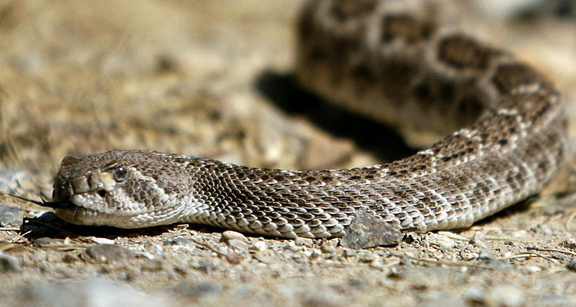
Yikes! A bite a day in just southern Arizona alone?! The Grand Canyon state is home to 13 species of rattlesnakes, with eight or nine species living in Southeastern Arizona, depending on how the region is defined, and on average, 150 to 160 rattlesnake bites are reported every year. Multiply those statistics by all the states where poisonous vipers live, and you know why you've got to be careful this summer!
Rattlesnakes typically come out of their winter dens in March or April, and return in November. They range far and wide — from deserts, canyons and forests to urban backyards. Some rattlers slither a mile or more from their dens to places where they spend the summer— many times in the same places where humans and dogs hike, camp, hunt and live. Some rattlesnake bites are so-called “dry bites” in which no venom is injected. Sometimes the dry-bite rate can be 20 percent. It all depends on the age of the snake, if it has recently eaten (and used its venom on the rodent it bit), and other factors.
“I’ve been a little bit paranoid just walking around the house now,” admits a home owner in Anaheim Hills, California who was hospitalized after she was bit in her own bathroom by a rattlesnake. Her neighbor’s Beagle was also bitten the week before by a baby rattlesnake. Both received anti-venom and are recovering. Fire officials say the appearance of rattlesnakes in Orange County is no rare occurrence. “The reason why we’re seeing more and more snake calls, and snake incidents, is because it’s so dry. It’s the fourth year of a serious drought, and it’s been so hot lately. These snakes are trying to find water.”
Rangers in Boulder County are warning hikers and cyclists to be on the lookout for snakes in the grass after a Wyoming resident who'd been visiting friends in Colorado was bitten on the shin by an adult snake that was about three feet long. The friends reportedly got off their bicycles and were crossing an open grassy area to go to a different trail when the woman was bitten. The victim was airlifted to a nearby hospital, treated with anti-venom, and was released.
"Contrary to many people's understanding, rattlesnakes do not deliberately harm people. They will only strike if threatened; otherwise, rattlesnakes will do everything possible to avoid a human encounter." Officials in Boulder caution people to watch where they step, particularly when in rocky or grassy open areas, and to be careful about what you wear. Especially this time of year the weather is beautiful and you want to wear shorts, but leaving one's legs bare and ankles exposed may not be wise for people who leave the traveled trails. Always keep your dogs on a short leash when hiking to minimize the opportunity for them to poke their nose where a prairie rattlesnake might be hiding.
Snake bite victims are generally not doing anything wrong. They are just in the wrong place at the wrong time— working in the yard or around a wood pile, or outside enjoying the summer— and nothing could have been done to prevent the bite. But if you are purposely going into known snake country to hike or hunt, the best prevention is to wear snake gaiters or snake proof boots.
If the worse happens, the best response to a bite is to go immediately to a medical facility for examination and treatment with anti-venom if needed. No cutting, no sucking, no tourniquets. Just get to a hospital. Other tips include not putting ice on the bite, and any limbs that are bit, whether it be on the arm or the leg, should be kept below the heart.
Friday, February 12 2016
It's only mid February, but high temperatures in many southwestern states, such as Arizona, are seeing an early spring warming trend, so now is a good time to remind everyone to beware of rattlesnakes! When snakes sense a litt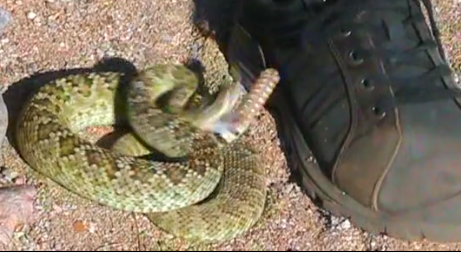 le bit of heat and humidity, they come out of hibernation, so now is the time they are becoming active again. Of course, no one sets out to encounter a snake, so the very best piece of advice is to be aware of your surroundings during rattlesnake season so you won't become a statistic. Two poison centers in Arizona alone treat an average 250-300 snake bite victims every year. The American Association of Poison Control Centers reported more than 750 rattlesnake bites in 2014 with 3 resulting in deaths. And that's just some of the stats. Minimize your chances of snake bite by following these tips: le bit of heat and humidity, they come out of hibernation, so now is the time they are becoming active again. Of course, no one sets out to encounter a snake, so the very best piece of advice is to be aware of your surroundings during rattlesnake season so you won't become a statistic. Two poison centers in Arizona alone treat an average 250-300 snake bite victims every year. The American Association of Poison Control Centers reported more than 750 rattlesnake bites in 2014 with 3 resulting in deaths. And that's just some of the stats. Minimize your chances of snake bite by following these tips:
- Wear closed-toe shoes. Sounds simple enough, but you'd be surprised at the number of sandal and flip-flop wearers on the trails. Above the ankle hiking boots and socks are even better - a lot of snake bites occur in the ankle area. Snake gaiters that cover from your ankle to your knee are your very best form of snake bite protection. And when hiking, don't just look straight down. Look ahead and to the side before you step. Although reptiles are most active during the months of April through October, during the hottest months they're most active at night. If it's dusk or dark outside, use a flashlight or headlamp to illuminate your path so you don't accidentally step on a snake.
- If you can't see it, don't stick your hand in it. This just doesn't apply to reaching under wood piles or into rock crevices, it also applies to golf. Don't stick your hand in a bush or a shrub for a wayward golf ball, as these areas are the perfect places for snakes to hang out. You don't want to startle one. Same theory applies if you're hiking or rock climbing or gardening. And remember, rattlesnakes can swim so look twice if you see a floating "stick" in the water!
- Don't underestimate a baby rattlesnake. There is no such thing as a cute rattlesnake. Baby rattlesnake venom is just as deadly as older snakes, and due to their smaller size, they can be harder to see and thus avoid. Younger rattlesnakes are born without a traditional rattle, so you can't always rely on the noise as a warning. Since rodents are a primary source of food for rattlesnakes, be sure to get rid of any rodents in your yard. Be careful with bird feeders too because those can attract rodents and snakes will be drawn to the smell of birds and rodents. Don't give those baby rattlers fuel for growing up!
- Practice proper trail etiquette. Experienced hikers know that there is an internationally accepted "triangle" of trail etiquette: Mountain bikers yield to runners, hikers and horses. Runners and hikers yield to horses. Horses are not required to yield to any group. But everyone and everything yields to snakes! Give them a wide berth if you spot one on the trail or even sunning itself on a rock. Don't try to kill or immobilize a snake. Save your pepper spray, too, because that won't work— just back away slowly and avoid a confrontation. If you are close enough to make a direct hit with the pepper spray, you’re close enough to get bit. Not a good place to be. And why aggravate a snake by spraying it anyway? Snakes don’t have eyelids, but they do have a transparent shield that protects their eyes, so the spray won’t really blind them. And while mammals are sensitive to the stuff in pepper spray, reptiles aren’t.
- Do not handle snakes even if you think they are dead. Believe it or not, some rattlesnakes can still strike and inject you with venom when they're dead. This is true even if the snake's head is cut off. Don't take a selfie or reach your hand out to touch it!
Snakes are always around, and with nicer weather, snakes and humans are becoming more active in the same environments so the potential for encounters increase. Unfortunately this can mean getting bitten while gardening, pulling weeds around your yard, walking to the mailbox, or hiking with your dog. There's a perception that most people are bit when they've been playing with or bothering a snake, but mostly it's acci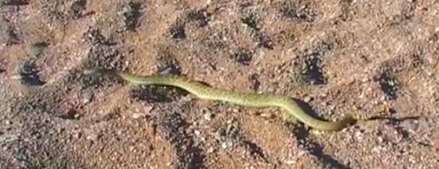 dental— being in the wrong place at the wrong time with a snake. dental— being in the wrong place at the wrong time with a snake.
Because the number of snake-bite reports increase as temperatures creep up, now is a good time of year to be reminded that being aware of your surroundings is the best thing you can do to stay safe in snake country. And if you frequently have a canine companion or two with you, consider a dog vest that protects them not only from snake bite, but from painful cactus needles, briars, and more.
Although you should be aware of the potential for a rattlesnake bite, don't be so worried you don't venture outdoors. Most people don't die as a result of a snake bite, as long as they get medical attention fast. The best thing you can do if bitten is to immobilize the wound and get to the hospital immediately. Most patients are out of the hospital in two days and then spend the next few weeks getting follow-up treatments. A typical person takes about a month to get "back to normal." Being bitten can cause severe injury and long-term complications, but being alert to the dangers of snakes and using snake bite protection can help you avoid them in the first place, and stay safe while in their territory.
Thursday, October 29 2015
Snakes are seen just about everywhere from spring through October, and then they are presumed to hibernate. But that's not always true. Snakes are more reactive to consistently cold weather, rather than a change of seasons. Rattlesnakes are even known to move around during extended warm periods during winter months, especially if they hole up in a stump or other location that can be warmed easily by sunshine. 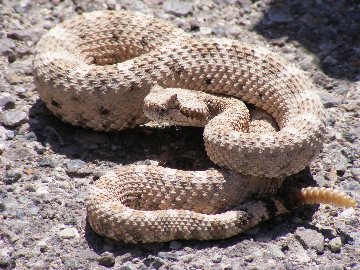
Snakes do not actually hibernate, rather they become less active during cold weather. It is called "brumation." Brumation is an extreme slowing down of their metabolism. Snakes are awake, but just very lethargic so you don't see them moving around. In the fall, snakes move back to the previous year’s den. If a sudden cold snap catches them before they get there, they may die if not fortunate enough to find a suitable secondary den. They usually do not stay long at the den entrance, but hurry in for the long winter sleep. A number of species may share the same den. For example, black rat snakes, timber rattlesnakes and copperheads commonly den together. Sometimes there will be as many as 100 snakes in one cave. A group site is called a hibernaculum.
Cold-blooded animals like snakes, fish, frogs, and turtles need to spend the winter inactive, or dormant, because they have no way to keep warm. Snakes will crawl into any area free from frost such as caves, hollow logs, holes under trees and stumps, under wood piles, in other animal's burrows, and occasionally in a person's basement.
Snakes will increase their intake of food before brumation occurs, if they can. Not all snakes will survive brumation. A skinny snake will not survive. If the snake feeds heavily before they hibernate, and have digested their meal before the cooling starts, they will be OK. If food is in their stomach or intestines when they cool, it will rot and kill them. Vipers can also brumate during normal conditions, due to a loss of food, but normally when they become dormant it corresponds with extreme temperature changes.
On warmer days in late fall, early spring, or even during winters, brumating snakes sometimes come out of their dens to bask in the sunshine. Nice sunny days that follow a long cold snap are often when people are surprised by rattlers. Just like humans, snakes head out to enjoy the sun and unsuspecting hikers can startle them and cause them to strike. Generally, rattlesnakes emerge from hibernation in March or April, or when the average daytime temperatures reach and remain about 60 degrees Fahrenheit and higher.
During a typical year, an estimated 45,000 people are bitten by snakes in the United States. That number is reason enough to always wear snake boots or snake gaiters when in the desert or the woods. If you do, you won't have to worry so much about the temperature or the season — use common sense to keep yourself safe. Hunters should be especially vigilant and wear snake protection!
Monday, September 14 2015
Stay safe in those snake infested areas at work and play. Browse snake gaiters here.
Monday, August 17 2015
There is some concern that the drought in California has led to an increase in rattlesnake bites across the state. Along with many 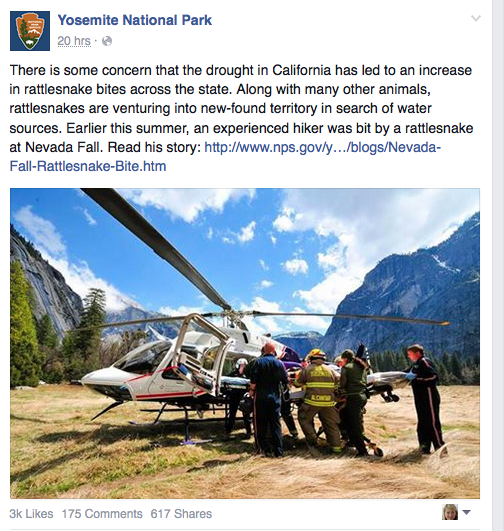 other animals, rattlesnakes are venturing into new-found territory in search of water sources. Earlier this summer, an experienced hiker was bit by a rattlesnake at Nevada Fall. The story was posted today on Facebook with a link to the Yosemite National Park website. Below is an excerpt: other animals, rattlesnakes are venturing into new-found territory in search of water sources. Earlier this summer, an experienced hiker was bit by a rattlesnake at Nevada Fall. The story was posted today on Facebook with a link to the Yosemite National Park website. Below is an excerpt:
On June 29, 2015, sometime around 4 pm, a 49-year-old day hiker at the top of Nevada Fall experienced what many people would consider their worst nightmare: being bitten, and envenomated, by a rattlesnake. He was an experienced hiker and had come across rattlesnakes in the wild before.
The top of Nevada Fall was the objective for the subject and his family. Upon reaching the footbridge at the top of the fall, they decided to do what many hikers feel the need to do after walking in the afternoon heat: take off their shoes and cool their feet at a safe spot in the river. As the subject made his way back onto the granite shoreline, he stepped down into a shallow recess between several rocks and was immediately bitten on the right foot. Moments later, another member of the subject’s family dialed 911 and reported the incident, at which time Yosemite Search and Rescue began to mobilize their response.
A rescue team began hiking to the patient's location as park helicopter 551 mobilized. Approximately one hour after being bitten, 551 airlifted the subject from the top of Nevada Fall and flown to the valley floor, where medical care was waiting. The clinic staff administered antivenom medication to the subject, stabilized him, and readied him for transport to a regional hospital via a medical helicopter.
Many people see rattlesnakes while hiking in Yosemite. Snake bites are rare here, but it is important to know that they do occur and that the resulting injuries can be serious: this subject spent several days in the hospital recovering from his bite. It is understandable that the patient was barefoot while wading, but for the rest of the hike, a pair of snake boots or other sturdy shoes can protect against many snakebites. Snake gaiters offer snake bite protection from approximately your knee down to your ankle and should be worn with sturdy boots. An important lesson to learn from this incident is to always be aware of where you place your hands and feet—in addition to snakes, crevices can hide scorpions, spiders, and yellow jacket nests. This hiker didn't do anything wrong. In this case it just happened to be that a viper proved to be the most dangerous part of the trip— not the obvious hazards of the quickly flowing river, the granite cliffs, or the midday heat.
If you are bitten, keep in mind that the most effective treatment for snakebite is to seek medical care at a hospital or emergency room as quickly as possible. Gone are the days when snakebite first aid involved cutting into the bite and sucking the venom out of the body. Don't try it! It doesn't work!
Finally, treat all wildlife with respect and give them the space they need to stay wild. Never approach wildlife to feed, pet, or photograph them. No matter how docile the animal or reptile may appear, it is wild and could spook easily.
Monday, August 03 2015
No one knows for sure how many people are actually treated for venomous snakebite annually, but according to a Parks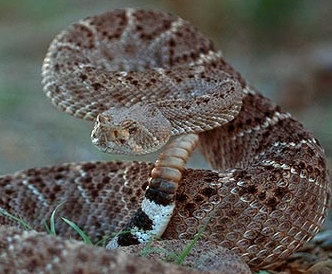 and Wildlife Department herpetologist, each state usually reports of one or two deaths per year. For those bitten who survive, treatment for rattlesnake bites reportedly runs anywhere from about $20,000 at the minimum up into the six-figure range. Anti-venom and treatment is very expensive! Young children out exploring and intoxicated young men make up a good chunk of the bite victims. Hikers and hunters also get bitten, as do those who work in and around snake habitat, especially when moving logs and rock piles. and Wildlife Department herpetologist, each state usually reports of one or two deaths per year. For those bitten who survive, treatment for rattlesnake bites reportedly runs anywhere from about $20,000 at the minimum up into the six-figure range. Anti-venom and treatment is very expensive! Young children out exploring and intoxicated young men make up a good chunk of the bite victims. Hikers and hunters also get bitten, as do those who work in and around snake habitat, especially when moving logs and rock piles.
To keep you and your family safe, it’s important to be aware of your surroundings and to know which venomous snakes you might encounter where you live, work, and play. Texas has the most snake bites annually in the country, usually between 500 and 1,000. One-third to a half of those bites are venomous. Experts in the Lone Star State say you only need to worry about four species: western diamondback rattlesnake, copperhead, coral snake, and cottonmouth (also called water moccasin). Size does not matter because they are venomous at birth.
Coral snakes spend most of their time under leaves and logs and few people ever see them. They really aren’t a threat unless they are handled. Cottonmouths have black and white chins, float on top of the water and are not all that common. The copperhead is the only snake in Texas that is a two-color banded snake. The majority of venomous snakes sighted in residential yards are the diamondback. This rattlesnake sheds within 10 days of being born and then scatters. Babies end up in some strange places, like back steps and garages, looking for mice and lizards to eat, so you’re most likely to see this snake around homes and sheds. Adult diamondbacks want to stay away from activities and people. The most common snakes people encounter that are not poisonous are rat snakes—the only large snake that climbs.
Texas, of course, isn’t the only state with vipers. Oklahoma is home to five species of rattlesnakes. Three venomous species call Pennsylvania home— the northern copperhead, timber rattlesnake, and eastern massasauga rattlesnake. In California, where more than 800 humans are bitten each year, there are at least six types of rattlesnakes to be concerned about. Arizona has 13 species of rattlesnakes, and Nevada has six. Alaska is the only state that has never reported a venomous snake. For a list by state, visit http://www.venombyte.com/venom/snakes/venomous_snakes_by_state.asp
The best suggestions for avoiding snake bite is common sense and prevention. Don’t walk through tall grass. Places like flooded pastures create great breeding sites for frogs and feeding sites for frog hunters like snakes. Walk around rock piles and logs instead of stepping over them. If you see a snake, leave it alone. Remember that snakes are just as active in the fall as they are in the spring, so hunters should be extra cautious. No matter which state you live in, it makes sense to think about snake bite protection in advance of being outdoors — simply wear snake gaiters or snake boots. If you are bitten, below are a few do's and dont's suggested by medical professionals:
What to Do if You Are Bitten by a Snake
- Call 911 immediately.
- Stay as calm as possible.
- Get away from the snake but stay as immobile as possible until help has arrived.
- Remove clothing or accessories that may restrict your blood flow and cause swelling.
What Not to Do if You Are Bitten by a Snake
- Don’t try to capture the snake – this is unnecessary and can lead to a more dangerous situation.
- Don’t create an incision or suction the wound.
- Don’t administer any drugs to the victim.
- Don’t apply a tourniquet (restrictive device used to constrict the flow of blood to a body part).
- Don’t apply ice to the snakebite.
- Don’t wait to see if symptoms occur – seek professional medical help immediately!
Monday, June 08 2015
Some experts say that snake bites are on the rise in some regions such as San Diego and Southern California, due to drought  conditions. Scarce water levels means low moisture content in plants, which in turn attracts fewer rodents, squirrels and rabbits — meaning less prey for snakes— so the vipers are on the move. Wildfires don't help the situation because habitat is disturbed, driving rattlesnakes farther into areas where there are more people. In addition to humans, more dogs have been bitten this spring, leading to more veterinarians giving snakebite vaccines to man’s best friend. And some reports indicate snake venom appears to be getting more toxic. This is worrisome to emergency room doctors who say it seems like vipers are packing a more deadly dose of venom than ever before. conditions. Scarce water levels means low moisture content in plants, which in turn attracts fewer rodents, squirrels and rabbits — meaning less prey for snakes— so the vipers are on the move. Wildfires don't help the situation because habitat is disturbed, driving rattlesnakes farther into areas where there are more people. In addition to humans, more dogs have been bitten this spring, leading to more veterinarians giving snakebite vaccines to man’s best friend. And some reports indicate snake venom appears to be getting more toxic. This is worrisome to emergency room doctors who say it seems like vipers are packing a more deadly dose of venom than ever before.
Other experts believe snakes are not affected by drought because they’ve evolved in areas where droughts are frequent. Their explanation for the increase in bites is because rattlesnakes are more active as daylight hours lengthen. The sun signals their pituitary glands to wake up, get food and find a mate. One park service employee said, "It is like real estate: location, location, location. More people are out on forest trails in spring in summer as schools let out, which leads to more encounters with snakes."
Whatever the reasons, biologists and doctors said agencies need to post more signs explaining how to prevent snakebites. Too many people wear shorts and flip-flops instead of long pants and snake gaiters with boots or sturdy shoes. Also, going off trail and being unable to hear a snake’s rattle because someone’s wearing earbuds with music blaring adds to the possibility of getting bitten. There's a good chance you've been close to a snake while hiking and never knew it. A snake's camouflage allows it to blend into its surroundings. The can be tough to see, so stay alert.
If you encounter a rattlesnake, the way you act will likely determine the experience you have. Like most animals, rattlesnakes fear humans. Give snakes spac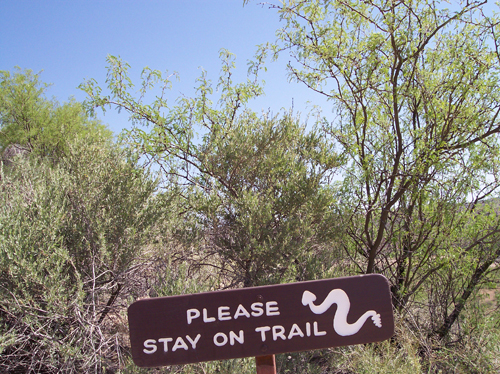 e, watch where you step, and watch where you place your hands when you sit down. Never hike alone, always carry a cellphone, and tell family members where you’re going ahead of time. If bitten, call 9-1-1. Stay calm. Don’t use tourniquets or try to suck out the venom. Get to a hospital as soon as possible. Although 25 percent to 50 percent of rattlesnake bites are dry bites (no venom), you won't know that when you are struck. Treatment for a rattlesnake bite can require up to four of five days in a hospital. e, watch where you step, and watch where you place your hands when you sit down. Never hike alone, always carry a cellphone, and tell family members where you’re going ahead of time. If bitten, call 9-1-1. Stay calm. Don’t use tourniquets or try to suck out the venom. Get to a hospital as soon as possible. Although 25 percent to 50 percent of rattlesnake bites are dry bites (no venom), you won't know that when you are struck. Treatment for a rattlesnake bite can require up to four of five days in a hospital.
If you encounter a rattlesnake while hiking, it is recommended that you do the following:
- Remain calm. Do not panic.
- Stay at least five feet from the snake. Give the rattlesnake plenty of space.
- Do not try to kill the snake. Doing so is illegal in some states (Utah is a good example) and greatly increases the chance the snake will bite you. Most venomous bites happen when untrained people try to kill or harass a snake. Usually the snake is simply moving through the area, sunning itself or looking for a place to hide. If you leave the snake alone, it will leave you alone.
- Alert other people to a snake's location. Advise them to use caution and to respect the snake. Keep children and pets away.
It is a myth that smaller rattlesnakes give more venom than adult snakes, but no matter the age or size, rattlesnakes are the most dangerous snakes in the world because they actually inject venom into you. Other species may bite and it is a grinding bite. Rattlesnakes, however, have hollow teeth with venom glands that act like a plunger in a hypodermic needle. With months of hot weather ahead, the number of snake bite victims easily could rise, especially in areas with droughts and wildfires. These conditions send the vipers scattering for food, which could increase the likelihood of encounters with humans. The best advice is to be prepared. Wear snake bite protection.
Wednesday, April 29 2015
Most rattlesnakes are out of their dens by mid-May, roaming the wild and occasionally alarming humans. The fear of snakes ranks 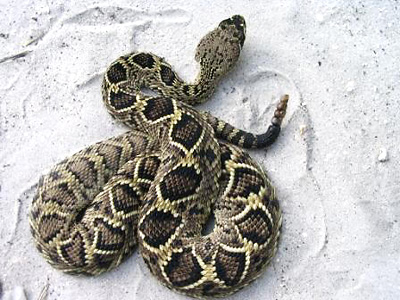 near the top of most common phobia lists, but do people in eastern states need to be worried about serpentine encounters as much as those in western and southern states? near the top of most common phobia lists, but do people in eastern states need to be worried about serpentine encounters as much as those in western and southern states?
Rattlesnakes are considered threatened or endangered in certain states such as Pennsylvania, New York, Ohio, New Jersey, Vermont, New Hampshire and Massachusetts. This particular venomous creature is vulnerable to loss of habitat and being run over by vehicles. Once the population is depressed, it takes the population a long time to recover because of slow reproduction rates. It takes females the first seven to nine years of their 30-year life to reach sexual maturity. They will then only have a litter every three to five years, and only one baby from each litter will likely survive to reach maturity.
Still, snakes are surviving in eastern snakes and whether you should be truly concerned about them while hiking, hunting, or working in your yard depends largely on how often you will be in areas known for snakes. Your best bet is to wear snake gaiters or snake boots while recreating or working in snake habitat. Rattlesnakes are unlikely to bite unless provoked — usually by a young person bitten on the hand because they attempted to pick it up. Children need to realize if you poke at it long enough, even the most docile snake of any species is going to strike. Also, if you startle a snake by accidentally stepping on it, or perhaps moving a rock or piece of wood not knowing a snake is under there, that's when bites can occur, too.
If you happen to get bit, do not cut or suck the wound or use a tourniquet to isolate the venom. Go directly to a medical facility as quickly as possible. Not all hospitals carry anti-venom, so it’s a good idea to call ahead. Some victims might need to be hospitalized. Although a rattlesnake bite can be very painful and expensive (anti-venom doesn't come cheap), it's not common enough to avoid hiking or fishing or otherwise having fun in the woods on a summer’s afternoon. Just be prepared with the right snake bite protection, use common sense, and be on the look-out so you can avoid any rattlers that are also taking advantage of a sunny summer day.
Tuesday, March 31 2015
Most times we want to AVOID snakes, but if you are a gardener, you just might be glad to see the "right" kind of snake gliding through your vegetable plants. The "right" kind of snakes consume a wide variety of garden pests. For example, the garter snake feeds on slugs; the sharp-tailed snake adds grubs to their diet, including the destructive Japanese beetle grub. Rubber boas specialize in eating mice and voles, and will even go down their tunnels after them. And gopher snakes snack on mice and rats.
Garter snakes are the most common type seen by urban and suburban gardeners. Depending on where you live, there are several species of this type of snake, such as the western terrestrial garter, the northwestern garter, and the common garter. Garter snakes generally breed in the spring and give birth to live young in the late summer or fall. The young are not often seen until the following spring, after they emerge from hibernation after their first winter. Most young garter snakes do not survive into adulthood because they are killed off by predators, cars, and lawnmowers.
 The common garter snake (Thamnophis sirtalis) is, well, the most common species in North America. You can generally recognize it by the pattern of yellow stripes on a brown or green background. Their average total length (including tail) is about 22 inches. The average body weight is only about 5 ounces. In summer, it is most active in the morning and late afternoon; in cooler seasons or climates, it restricts its activity to the warm afternoons. In warmer southern areas, the snake is active year-round; otherwise, it sleeps in common dens, sometimes in great numbers. For humans, a bite is not dangerous, though it may cause slight itching, burning, and/or swelling. The snake's salivia is poisonous to its prey. The common garter snake (Thamnophis sirtalis) is, well, the most common species in North America. You can generally recognize it by the pattern of yellow stripes on a brown or green background. Their average total length (including tail) is about 22 inches. The average body weight is only about 5 ounces. In summer, it is most active in the morning and late afternoon; in cooler seasons or climates, it restricts its activity to the warm afternoons. In warmer southern areas, the snake is active year-round; otherwise, it sleeps in common dens, sometimes in great numbers. For humans, a bite is not dangerous, though it may cause slight itching, burning, and/or swelling. The snake's salivia is poisonous to its prey.
If you have pets, the likelihood of attracting garter snakes is minimal, but if you want to make your garden or lawn garter snake friendly, follow this advice:
• Walk your lawn before you mow it to scare the snakes into hiding. Lawn mowers are deadly to snakes because they can't hear like humans do. Rather, they feel vibrations.
• Provide habitat for snakes if you have room. Old plywood or corrugated metal roofing left loosely on the ground in an out-of-the-way place on your property provides hiking and nesting places for snakes. Old stumps and large rocks also make good snake habitat. Keep in mind that these very habitats can also attract the WRONG kind of snake such as rattlers and other venomous vipers.
• Don't use chemicals such as pesticides and fertilizers in areas used by snakes, including lawns.
Of course rattlesnakes feed on mice, rats, and other small animals that you might want to get rid of, but they are not exactly the type of slithering creature you want to attract! If you live, work, or play in rattlesnake country, wear snake gaiters or snake boots and be safe!
|